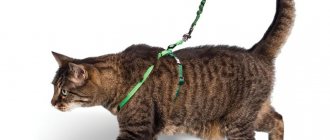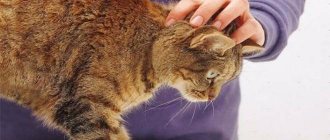In what cases is euthanasia required?
There are times when the only thing the owner can do for his beloved but unhappy cat is to euthanize him for medical reasons.
Modern techniques allow euthanasia to be carried out painlessly and unnoticed by the pet.
Euthanasia is recommended in the following cases:
- Congenital defects incompatible with life.
- Acquired, incurable diseases, accompanied by severe, constant pain.
- Injuries leading to the inability of the animal to move independently, feed, etc.
You can guess about the unbearable pain present in your pet by its behavior. The cat hisses, reacts painfully to any touch, and moves with uncertainty.
How to identify the cause of anger in a cat
There may be several reasons why a cat can react so painfully to its surroundings, and they are not always obvious to the owner.
Fear
The main reason for the “brutality” of a cat driven into a corner by a difficult situation and not receiving support. Such an animal has no other choice but to attack. Any non-standard or unpleasant situation can cause fear - from a sharp sound and bright light to procedures in the veterinary office.
Fear makes an animal's behavior unpredictable
Veterinarians often observe classic aggression from fear. It looks like this:
- the cat shrinks into a ball and tucks its tail, trying to become as small as possible;
- the cat may urinate, defecate or mark;
- horror appears in the animal’s eyes, then anger comes.
Fear forces the animal to express the request with its entire body and behavior: “Leave me alone!” However, the stressful situation continues for various reasons, and the pet decides that he has only one way out - an attack.
How to cope:
- If possible, leave the animal alone;
- provide shelter (carrying, dark corner) until calm.
In the future, the cat needs to be gently removed from the state of stress and socialized.
Pain
The cat was friendly and calm, and suddenly began to hiss and rush at people and animals? Such behavior can be the cause of illness, even with seemingly convincing external signs of her health.
Aggression in a cat can be one of the signs of pain
There are diseases that occur without external manifestations, for example:
- epilepsy;
- toxoplasmosis;
- encephalopathy;
- hyperthyroidism;
- heavy metal poisoning.
It is necessary to check the pet's health - consult a doctor, do an ultrasound, take blood, feces and urine tests.
If you notice any abnormal manifestations, contact your veterinarian
An aggressive reaction can occur if a person, while caressing a cat, accidentally touches a sore spot. There are also cases of a cat attacking if the owner steps on its paw, or a child causes pain to the animal (pulling the tail, squeezing it). If a cat is over 12 years old, it may develop age-related diseases, for example, arthritis - you should handle an older pet with extreme care.
A game
It is common knowledge that cats sometimes bite their owners' legs. This happens if:
- do not play with the animal;
- the cat survived on the street alone;
- the kitten was taken from the litter too early (before 3 months).
Unpleasant manifestations are “treated” with the help of education (teach the animal that bites and scratches immediately stop fun play and communication) or interactive toys that will keep the cat occupied for a long time.
A cat may bite its owner due to lack of attention
Claims to territory
Most often, this type of aggression occurs between cats, but can be directed at a person or another pet. A territorial war is almost guaranteed to break out if you have a couple or more uncastrated animals of the same sex living in your home.
How to cope:
- take animals to a veterinarian for spaying or neutering;
- place bowls of food in different rooms or corners;
- Buy each animal a separate tray.
Protection of offspring
If the kittens are in danger (or appear to be), the mother cat may react inappropriately to people and other pets in order to protect her young.
By protecting the cub, the cat becomes a tigress
How to cope:
- do not disturb the cat and kittens unnecessarily;
- arrange a reliable and safe corner for the cat family;
- limit contact with people and other animals as much as possible for 2-3 weeks.
Reaction to affection
Maybe you touched a sore or, from the cat’s point of view, inappropriate place, or the cat has become overexcited and can no longer tolerate physical contact.
Before an act of aggression, a cat usually gives signals:
- meows;
- twitches skin;
- wags or beats its tail;
- stops purring;
- flattens ears or twitches them;
- crouches, trying to avoid touching.
Pay attention to your pet's signals and you will avoid an aggressive attack
If you weren't careful, you'll get bitten out of turn
Sometimes a cat's aggression can be redirected. The animal heard a sharp sound, experienced pain, noticed an inaccessible stress factor, but does not understand the cause of the discomfort or cannot reach it and eliminate it. A classic case is when a cat sees another cat outside the window, but cannot go out and make territorial claims to it. Then the animal may attack a person or another pet, trying to get rid of discomfort.
Methods of painless euthanasia and drugs
The anesthetic part of euthanasia takes place in several stages:
- Intramuscular injection of a relaxing drug - a muscle relaxant. Under its influence, the animal’s body completely relaxes.
- Introduction of basic anesthesia. Intravenous and subsequent intramuscular injection of a sedative at intervals of 3-4 minutes. After the injections, after a short period of time, the animal falls asleep.
To reliably euthanize cats, injections based on drugs are used:
- sodium thiopental;
- sodium hydroxydione succinate;
- gilded;
- T-61.
These drugs have analgesic, sedative, anticholinergic, and antihistamine effects.
Preparations for euthanasia
In the vast majority of cases, euthanasia is carried out by injection. There are two options:
- Anesthetic agents. Narcotic anesthetics, or barbiturates, are administered in a lethal dose, usually three times the operating dose. The animal falls asleep after the injection, and cardiac arrest occurs during sleep.
- Killing substances. Before administering them, the animal must be given general anesthesia and wait until it is deeply asleep - otherwise the injection will be extremely painful.
Do not agree to use drugs from the group of muscle relaxants (xylazine, killin, etc.) without anesthesia! These substances relax the muscles to the point of paralysis, and the animal dies in agony from suffocation, although outwardly it seems calm due to the inability to move.
Injections are usually given intravenously. Another method of administration is used if it is difficult to enter the animal's vein.
If the cat is very nervous, she is given a sedative in advance.
How to put a cat to sleep temporarily?
Sometimes it is necessary to put the cat to sleep for a while, for example, in order to:
- medical manipulations;
- hygiene procedures.
Be sure to read:
How many toes does a cat have: the norm on the hind and front paws, possible pathologies
Veterinarians in hospital settings use strong sedatives such as Vetranquil, Rometar, Propofol to calm animals.
More suitable for home use:
- Stop stress;
- Fitex;
- Cat Baiyun.
Important! The drug and dose are prescribed by a veterinarian!
Purposes of euthanasia and euthanasia
- euthanasia is a reversible process, as a result of which the animal falls asleep not on its own, but under the influence of medications that affect the functioning of the brain;
- euthanasia is an irreversible process, the deliberate and controlled deprivation of an animal’s life by successively shutting down nervous, cardiac and pulmonary activity in order to end the hopeless long painful existence of the body.
Why do you need to understand the essence of these two terms? To make it easier to understand why you need to euthanize your cat and whether it is possible to do it at home yourself. So let's get started.
It is very rare to meet a calm and obedient cat that will meekly carry out all the commands of its owner. Often, purebred mustachioed shrews behave very impudently and willfully. They show their character in all its glory when they need to be put in a carrier, taken out of the apartment or transported somewhere, especially if the purpose of the trip is to visit the veterinarian. With the most zealous representatives of the feline species, such manipulations can cause great problems for the owners, and sometimes even physical injuries in the form of scratched hands, fingers, neck and face.
In such situations, some people prefer to reduce stress for themselves and the animal by putting it to sleep with a short-term sleeping pill. It’s not difficult to do this yourself at home. It is enough to purchase a sedative based on phytocomponents (Fitex, Stop-Stress) from a veterinary pharmacy. Having received the dose required for its weight, the animal calms down and falls asleep.
In addition to herbal sedatives, there are also medications - sleeping pills for animals. With their help, veterinarians put cats into a narcotic state (anesthesia) before complex surgical operations. There is no point in providing a detailed list and dosages of these medications here, since you will not be able to euthanize a cat at home with these medications yourself. They are not freely available without a prescription and cannot be found in pharmacies.
This is where a logical question arises: how then can you alleviate the pain of an old dying animal?
How are cats euthanized in veterinary clinics?
Before the procedure, the veterinarian examines the animal and determines its weight.
The killing of cats in veterinary clinics is carried out according to the principle of humanity in several stages:
- Relaxing injection.
- Basic anesthesia, which puts the animal into deep sleep: the central nervous system is blocked, the receptors do not function. At this stage, the pet is in a state of absolute immunity to the environment. The cat does not hear, does not feel.
- Heart failure. It is carried out in different ways: by injecting a special drug into the heart muscle, or by administering a sedative drug by intravenous injection. The procedure is painless. Breathing stops.
- The heart is listened to with a stethoscope, the doctor diagnoses the death of the animal.
Sometimes in old or severely weakened cats, cardiac and respiratory arrest is recorded at the second stage of euthanasia.
The drug and dose are prescribed by a veterinarian
Euthanasia by veterinary clinic specialists has a number of advantages:
- high-quality certified drugs are used;
- the dosage of the medicine is determined by a qualified veterinarian according to the attached instructions, taking into account the weight, age of the cat, and concomitant pathologies;
- the ability to choose the location of the procedure: at home or in the hospital;
- the opportunity to entrust the disposal of the body of a euthanized animal to specialists from a veterinary clinic.
The method and drugs for euthanasia are determined by the doctor based on the condition and pathology of the animal.
Where is it held?
The procedure for euthanizing a cat can only be carried out by a veterinarian. But the owner has the choice of the location: in the clinic or at home. From the point of view of animal psychology, it is better to do this at home, in the conditions familiar to the cat, where she spent most or all of her life.
The additional journey to the clinic can cause stress and add to the anguish of the last moments of life. But if the cat has often been to the clinic for preventive examinations or vaccinations and knows the doctor well, it can go there too. The fact is that for some owners, euthanasia at home can cause a certain emotional blow, and after the procedure, the place in which it will be carried out will become associated with the loss of their pet.
Each owner must analyze all psychological aspects and choose a place where euthanasia is least likely to traumatize his pet and himself.
ATTENTION! It is forbidden to euthanize an animal yourself, even if you buy special medications. This can only increase his suffering.
Cost of the procedure
The cost of euthanasia varies between 1000-2000 rubles and depends on the following factors:
- size of the settlement (in megacities the price of the service is approximately 30% higher than in small towns);
- veterinary clinic level;
- pet's weight;
- list of services provided (home visits, subsequent cremation, etc.).
Calling a specialist to your home will increase the total cost by an average of 1000-1500 rubles. Sending a deceased cat for cremation will require an additional at least 500 rubles.
Be sure to read:
How much does a cat weigh: table by age and breed, assessment, deficiency, norm and excess
In many clinics, the price for euthanizing an animal weighing up to 10 kg is fixed. The cost of the procedure for larger animals is negotiable.
Some veterinary hospitals offer lower price lists for euthanasia services. The main criteria when choosing a clinic should not be the amount of material costs, but the professionalism of the doctors and the quality of the drugs used.
How to recognize scammers when ordering euthanization of animals at home
The main goal of scammers is to get more money. They do not care about the sterility of the injection, use cheap drugs, and therefore do not allow the owners to be present during euthanasia. You can recognize impostors by looking at the addresses of veterinary clinics: offices are located at gas stations, in residential premises, or there is no address at all.
Another characteristic feature of scammers is the lack of fixed prices. Over the phone, the administrator can tell you one price, and the veterinarian after arrival can tell you another. They can even take money for drawing up a pet euthanasia plan. If the veterinarian refuses to conclude an agreement, does not allow you to be present during the procedure, or does not name the drugs that will be administered to the cat or dog, you should refuse his services.
How to painlessly euthanize a cat at home?
Situations when a decision is made to euthanize a cat at home are not uncommon.
Reasons for this choice:
- Loving pet owners understand that transporting a seriously ill animal to a veterinary clinic will bring additional suffering. In a familiar environment, the animal feels more comfortable and calm.
- The death of a beloved cat is a tragedy for a person; it is psychologically easier to bear the death of a pet at home.
- Lack of free time for the owner.
Doctors often euthanize cats at home . Technically, the procedure for euthanizing animals at home is similar to the procedure in a veterinary clinic: the same medications and veterinary instruments are used.
The close presence of the animal owner obliges the specialist to carry out all euthanasia procedures in accordance with the required medical rules.
How to carry out the procedure quickly and painlessly?
Carrying out the procedure at home requires the participation of a veterinarian. It is unlikely that you will be able to help your pet die quickly and painlessly on your own. Only a professional can calculate the dosage of drugs so that the pet falls asleep peacefully without experiencing suffering and agony. Independent actions can turn euthanasia from an easy way of dying into a painful and painful one.
Preparing for euthanasia
The procedure does not require any special preparation, the main thing is to prepare for it mentally. It is necessary to decide on the place in the house where it will take place. Children need to be taken out of the house - they may receive psychological trauma from what they see. It is not worth killing one pet in front of another, so healthy animals should be isolated. It is necessary to decide in advance the question of the future fate of the body.
If you decide to trust a professional, you need to find a veterinarian who has experience in performing the procedure. The date and cost of euthanasia, the drugs that will be used to induce anesthesia and stop vital activity, and the course of the procedure are discussed with him in advance.
Drugs used
To induce narcotic sleep, anesthetic drugs (propofol, lidocaine, droperidol) and barbiturates (sodium thiopental, pentobarbital, hexenal, phenobarbital) are used, which have a depressant effect on the central nervous system. In large doses, these drugs cause respiratory arrest. Killing of sick animals is carried out either by subsequently increasing the dose of these drugs, or by administering one of the following drugs (the animal must be immersed in a narcotic sleep):
- Depolarizing muscle relaxants - ditilin, listenone, adiline, succinylcholine, suxamethonium. In small doses they immobilize, in large doses they cause respiratory arrest due to relaxation of the respiratory muscles.
- Magnesium sulfate. Respiratory and cardiac activity cease due to vascular collapse.
- Lidocaine. Local anesthetic and antiarrhythmic agent, acts similarly to the previous drug.
- Potassium chloride. Relaxes the muscle tissue of the heart, causing it to stop.
These medications are actively used in Russia, and other drugs are used abroad. In the United States, dying animals are often given euthanasine. Its active ingredients are procaine hydrochloride and potassium chloride. They reduce contractile activity, conductivity and excitability of the myocardium, causing cardiac arrest.
In European countries, the drug “T-61” is used for euthanasia. It contains the powerful opioid analgesic embutramide, the muscle relaxant mebesonium iodide and the local anesthetic tetracaine hydrochloride. First, anesthetic substances act, plunging the cat into a narcotic sleep, then the muscle tissue relaxes, the heart and breathing stop. Sometimes this sequence is disrupted, the animal remains conscious and suffers, so preliminary use of sleeping pills is mandatory.
Progress of the procedure
Manipulations performed at home are similar to those performed in the clinic. The cat is given an injection of a drug that has an anesthetic and hypnotic effect. When narcotic sleep occurs, a medication is administered that blocks the respiratory center and causes cardiac arrest. The process takes 15–20 minutes.
Establishing the fact of death
Veterinarians establish the fact of death based on the cessation of cardiac and respiratory activity. To do this, the chest is listened to using a phonendoscope. The main signs of the death of an animal: lack of consciousness, heartbeat and breathing, mucous membranes and skin becoming bluish.
Once death has been declared, the body should be handed over to a veterinarian for removal and cremation. Independent burial of an animal in Russia is prohibited at the legislative level.
Self-euthanasia at home
Doctors often euthanize cats at home.
Euthanasia of an animal requires certain skills and knowledge from a person; the procedure is complex from a psychological point of view. Experts do not recommend carrying it out to a cat owner who does not have experience in such work.
Sometimes people are in a hopeless situation and decide to euthanize their pet on their own for the following reasons:
- financial difficulties;
- a significant distance between the house and the veterinary hospital;
- problems with free time.
However, veterinarians warn that it is not possible to purchase the necessary medications: such medications are issued only to licensed specialists or veterinary clinics.
The use of low-quality analogues can significantly complicate the euthanasia process and cause painful convulsions in the animal. In addition, it is difficult for an inexperienced person to determine the correct dosage of medications. It is absolutely unacceptable to use various poisons for another purpose during euthanasia.
The conclusion of the professionals : it is impossible to euthanize a cat at home without pain for the animal!
Animal euthanasia and religion
Believers ask the question: can putting a cat to sleep be equated to a mortal sin? There is no clear answer. Some clergy believe that euthanasia is a sin and one cannot go against the will of God, who endowed a living being with suffering. Others, on the contrary, separating the souls of humans and animals, are of the opinion that cat euthanasia is a benefit that helps the pet get rid of worldly torment.
In any case, the heavy burden of deliberate deprivation of life lies on the shoulders of those who made the decision and those who carried it out. Only by acting according to the laws of conscience, being confident in the inevitability of the pathological process, can you achieve peace of mind and not worry about what you have done.
KotoDigest Thank you for subscribing, check your inbox: you should receive an email asking you to confirm your subscription
What to do with the animal's body (cremation or burial)
What to choose: a regular burial in the ground or cremation of a deceased pet is decided by the owner, depending on financial and other possibilities.
Be sure to read:
Fat tail in a cat: what is it, normal or pathological, what to do, how to get rid of it, features of different breeds
The laws of the Russian Federation prohibit burying animal corpses in urban areas and areas adjacent to the city. Violation of the law is punished administratively - a fine is issued.
In most cases, it is wise to cremate the cat's body.
In large cities there are special ritual agencies for animals that offer the following services:
- 24-hour removal of the body of a deceased pet to the factory;
- return of ashes after cremation.
Sterile and safe ashes can be buried in the forest or in a summer cottage, placed in an urn and placed at home in memory of your beloved pet.
Funeral agencies provide their services for a fee; individual cremation of a deceased cat costs about 1,000 rubles.
Animal cremation
The body of a pet can be buried in a cemetery, but within the city limits this is often difficult to do. Our Veterinary Funeral Service provides cremation services for dogs, cats and other pets. After euthanizing the animal, we will deliver the corpse to the crematorium for burning using our own transport. If desired, owners can attend the cremation. The ashes are placed in an urn made of ceramic, wood or other materials. The design is laconic, the lids are hermetically sealed. After cremation of a cat or dog, you can bury the ashes with an urn in the cemetery or keep it as a reminder of your faithful friend.
Urns for animal ashes
Urn 32×19 large 2000 rub.
Urn 20×12 white 1500 rub.
Urn 20×12 black 1500 rub.
Urn 20×12 dog 1500 rub.
More urns in our catalog.
Preparations for euthanasia of dogs and cats
Author: Anton Ezhov Category: Drugs Euthanasia of animals always causes a storm of emotions and discussions. However, the shocking increase in oncological diseases, serious injuries and incurable destructive pathologies are forcing animals to be euthanized. When medicine is powerless and the animal suffers, euthanasia becomes the only way out of the situation.
Alarms
Owners of dogs and cats should be aware of the main symptoms that indicate the suffering of their pets. Dogs begin to frequently or continuously whine, bark, and howl protractedly. They may refuse to eat, and normal bowel movements are disrupted. An important symptom: lack of sleep. The animal is in so much pain that even in complete exhaustion there is no way to “fall” into sleep. Cats are usually in a state of complete apathy. They are lethargic, half-asleep, and almost do not react to stimuli. Against the background of such calm, a real “pain storm” flares up inside.
Reasons for euthanasia
In general, an animal can be euthanized for two reasons: medical reasons or social problems. Medical indications include: 1. Myelitis; 2. Spinal cord rupture; 3. Extremely severe neurological disorders; 4. Advanced destructive processes of the spinal cord; 5. Hepatic coma; 6. Acute renal failure against the background of several chronic diseases and the inability to resuscitate the animal through therapeutic measures; 7. Osteosarcoma; 8. Angiosarcoma; 9. Leukemia; 10. Any tumors that recur more than 2 times against the background of intense metastasis of the body; 11. Respiratory failure that cannot be treated; 12. a false social situation when a pet requires long-term and expensive therapy, but the lack of financial resources provides the only alternative - to euthanize the animal in order to deprive it of suffering.
Towards death
“Old-fashioned” methods of euthanasia involved the use of electric current, the introduction of alcohol or ammonia into the respiratory tract, and insulation. This is inhumane, unaesthetic and very painful for the pet itself. Thus, the philosophy of euthanasia itself, as a procedure of deprivation of suffering, is leveled, since just before death the pet is subjected to terrible torment.
Preparations for euthanasia
Today, progressive veterinary clinics offer drug euthanasia, which will allow a cat or dog to die as painlessly as possible.
Let's look at the main groups. Sedatives: 1. Xylazine is a centrally acting drug that relaxes muscles and depresses respiratory and cardiac activity. Acts as the optimal “tool” for inducing anesthesia. Anesthetics: 1. Etaminal - a drug that causes respiratory arrest; 2. Thiopental – puts the pet into a state of deep anesthesia, as a result of which the pet is deprived of any pain; 3. Propofol – used for anesthesia. In large doses, it can instantly suppress the activity of the respiratory system; 4. Droperidol is a neuroleptic tranquilizer. It is used as one of the drugs for inducing a state of anesthesia and further shutting down vital functions. Relaxants: 1. Ardaun is a relaxing drug that blocks the nerve passage of nerve impulses through the muscles. Used in complex therapy. Auxiliary pharmacological drugs: 1. Lidocaine – a drug for pain relief; 2. Magnesia – depresses cardiac activity and stops breathing in large doses. In domestic veterinary hospitals there are no special means for euthanasia, so you have to use drugs, the combination of which will lead to a painless death. In the States and Europe, such drugs as “Euthanasin” and “T-61” are used as more modern and convenient drugs. xn--80adjapb7awdo4m.xn--p1ai
Euthanasia procedure
Euthanasia requires certain drugs, which can only be used correctly by a professional and preferably in a clinic.
However, in certain cases and for a fee, this procedure can be done at home. The final decision, of course, remains with the animal owner.
In the clinic
Clinical euthanasia is the most common method of involuntary termination of the life of a sick animal.
Important! An experienced veterinarian will always tell you how the euthanasia process goes, what the animal experiences and describe in detail each of his actions. For such a procedure, there are a number of specific steps that every veterinarian must follow:
For such a procedure, there are a number of specific steps that every veterinarian must follow:
- The owner gives written consent to euthanize the pet, indicating the reason.
- The euthanasia process is always preceded by the administration of a sleeping pill (anesthesia). This is the mandatory first step in starting euthanasia (intravenously or intramuscularly).
- The animal falls into a deep sleep and stops responding to surrounding stimuli.
- The veterinarian injects a muscle relaxant, which slows down the heart and gradually stops breathing.
- Cardiac activity is listened to to determine the fact of death (mainly using a stethoscope, less often using ultrasound).
Euthanasia at home
To reduce the suffering of the animal and deprive it of unnecessary stress, you can carry out euthanasia in the environment familiar to it, that is, at home.
To do this, you need to find a specialist (you must make sure that the veterinarian is qualified) who will come home with the necessary medications and do everything necessary to make life easier for your pet.
We advise you to read about the life expectancy of dogs, cats, hamsters and budgies at home.
The procedure for euthanasia at home is the same as in the clinic:
- The owner signs a document making a decision about the need for euthanasia.
- The doctor administers preliminary anesthesia.
- After the animal falls into deep sleep, a sedative drug is administered directly, which gradually slows down the heartbeat and breathing.
- The heartbeat is heard and if there is no heartbeat, the doctor informs the owner that everything was painless.
How does the procedure work?
Euthanasia of a cat can take place in a veterinary clinic or at home. But in each case, the procedure should only be carried out by a veterinarian, otherwise it can turn from a painless death into a painful torture for the animal. Firstly, the necessary drugs are available only by prescription, and the use of analogues can only cause increased pain, spasms and martyrdom in the animal. Secondly, only a specialist knows how to correctly calculate the dosage, taking into account the age and size of the pet, so that he simply falls asleep peacefully.
When the decision is made, first of all, the owner will have to sign documents consenting to euthanasia, indicating the reasons for the procedure. If desired, he can attend the veterinarian’s manipulations or leave the premises.
Humane euthanasia involves two stages:
- Introduction to a state of anesthesia (the so-called vegetative coma)
. A special drug is introduced that “turns off” the animal’s nervous system, it stops feeling anything and reacting to external stimuli, but at the same time maintains breathing and heartbeat. Preserved breathing is the main indicator of the administration of an anesthetic agent, and not a muscle relaxant. - Administration of a drug for euthanasia.
After about 20 minutes, the veterinarian checks the depth of anesthesia and administers a second drug that stops all vital functions: breathing, brain and heart function. When all vital signs are zero, the veterinarian pronounces death.
Even if the owner has the opportunity to “get” the drug for euthanasia, it is not worth carrying out the procedure. You can make a mistake with your choice and purchase a remedy for the second stage of the procedure, which will provoke near-death torment (convulsions, pain, panic). For painless euthanasia, two drugs must be administered alternately.
After euthanasia, burial or cremation of the body will also be required, which also needs to be thought about in advance.
In the first case, it is important not to choose a prohibited place (for example, the city and surrounding areas). In some cities, special animal cemeteries are equipped for this purpose.
In the second case, you must first find a veterinary clinic or funeral agency that performs cremation, which will involve additional costs.
Euthanasia of a cat
Typically, the basis for the decision to euthanize any pet, including a cat, is the recommendation of a veterinarian. Most specialized veterinary clinics in large cities carry out the euthanasia procedure within their walls, offering the cat owner additional services for cremation or burial of the euthanized animal. In this case, the veterinary institution must have a special license (permit) for euthanasia and burial or disposal of corpses.
To carry out euthanasia, in addition to the veterinarian's opinion, the written consent of the cat owner is required. In order to euthanize a cat, its owner must sign a document in a standard form, which explains the concept of “euthanasia of an animal” (they try to avoid the terms “killing” or “euthanization”) and provides a description of how the operation will take place. A detailed description of the procedure indicating the medications and the signature of the animal owner allows the veterinary institution workers to avoid any claims or accusations of inhumane treatment not only from the cat owner, but also from various militant organizations for the protection of flora and fauna.
The procedure for euthanasia of a sick or decrepit creature is quite close to the operation of voluntary death of a person, permitted in some countries of the world (Belgium, Canada, the Netherlands and some states of the USA):
- at the first stage, the animal is administered analgesic and hypnotic drugs, which immerse the animal in a state of deep anesthesia;
- when special narcotic drugs are administered intravenously, euthanasia can be performed by increasing the dose of the sleeping pill;
- after the cat falls asleep and stops responding to external stimuli, it is given an injection of medications from the group of muscle relaxants, which either block the respiratory center or lead to cardiac arrest;
- An ultrasound scanner is used to confirm death due to veterinary euthanasia, after which cremation can be carried out.
The owner of a cat should know that no professional veterinarian working in a veterinary clinic with a good reputation will insist on medical killing. He only offers euthanasia as an alternative to the physical torment of the animal and the spiritual suffering of the owner, for whom the cat has become full-fledged members of the family over 10-15 years of coexistence. If for some reason the offered services do not satisfy the animal owner, he can consult another veterinary hospital or choose the option of euthanizing the cat at home.
But what you should avoid is inviting an “advertising specialist”. To euthanize cats in a clinic, a veterinary institution is issued an advisory permit, which in itself presupposes the presence of personnel with a certain level of knowledge and qualifications. The veterinary clinic has a set of specialized medications for euthanasia and equipment (ultrasound scanner) - all this makes euthanasia painless, takes a short time and guarantees the most effective result, also with subsequent cremation of animals.
At the same time, unlicensed “experts,” even if they have a veterinary education, strive to quickly get money for their services, without taking into account how the animal being killed feels. Facts of killing cats and dogs with Lysthenon, Suxamethonium chloride or the drug Super Adilin have been repeatedly published. These drugs belong to the group of peripheral muscle relaxants, although they are approved for use, but only in veterinary institutions with preliminary anesthesia and anesthesia of the object of euthanasia.
Euthanasia - painless care
“It is better to help quickly go away than to allow the disease to plague your beloved four-legged friend for a long time and suffer at the same time,” this is the opinion of many supporters of euthanasia of sick animals.
Carrying out humane euthanasia, which alleviates the suffering of a pet, is practiced in many veterinary clinics. When someone decides to carry out such a procedure at home without professional help, it can very easily turn into a brutal cold-blooded murder with elements of torture. The fact is that the process of painless euthanasia is very complex and consists of several stages, each of which is important and cannot be skipped either due to inexperience, much less deliberately. What are these stages?
Diagnostics
No matter how bad your cat feels, do not rush to bury her. First of all, you need an experienced look and good advice from a professional, or preferably several. When various specialists give your kitty a disappointing diagnosis: a disease incompatible with life, which will progress every day and cause her more and more suffering, only then can they give you a recommendation to undergo euthanasia. Forced euthanasia is used in cases of rabies; in other cases, the final word remains with you.
Termination of life is usually recommended for the following diseases:
- oncology of important organs (liver, lungs, kidneys, metastases to the spinal cord);
- serious injuries after an accident (multiple fractures near important organs);
- inflammatory diseases of the spinal cord, its rupture (as a consequence of renal failure);
- severe infectious infections that threaten an epidemic (rabies, distemper, various infestations of advanced parasites, such as leptospirosis, dirofilariasis and others).
Preparation
This stage is not so much needed by the animal as by its owner. It consists of a detailed consultation with the doctor who will perform the procedure. After such a conversation, you should not have any questions or doubts. The patient's owner must provide the following information:
- what will be used to euthanize the cat at the first stage (anesthesia);
- what will happen in the animal’s body during anesthesia;
- what drugs will be administered to stop the functioning of the brain, heart, and respiratory organs;
- where euthanasia will be performed - in a clinic or at home (you can choose the place yourself);
- what will happen to the body after the procedure.
If for some reason the doctor does not want to provide you with such information, look for another clinic. Apparently, euthanasia is carried out in this place using painful methods (without anesthesia, live), which they do not want to inform the client about.
The immediate process of euthanasia
At this stage, the cat is immersed in a narcotic sleep using a special drug from the so-called barbiturate group (sodium etaminal, Torbugesic, Ketamine and the like), which switches off the brain by deep depression of the central nervous system. In this state, all types of sensitivity are switched off in the body. This process may be reversible or irreversible depending on the dosage.
During normal anesthesia (during surgical operations), brain activity is only suppressed. During euthanasia, an amount of drug is injected that completely shuts down the brain. At this stage, the cat falls into a so-called vegetative coma. In this state, her heart continues to beat, there is still intermittent breathing, but she no longer has consciousness. She turns into a plant. In fact, this is the death of your pet.
At this moment, the farewell to your four-legged friend is completed: after making sure that the animal no longer feels anything, you leave the room. Next, a good specialist will carry out the final stage of euthanasia without your presence.
Physiological death
15-20 minutes after the brain is turned off, a lethal dose of potassium chloride is first introduced into the body, which, gradually slowing down, stops the heart muscle. Following the heart, breathing is turned off by administering ditilin, lidocaine or other relaxants. After some time, having made sure that all vital signs have completely stopped, the doctor completes euthanasia with a message about the death of the pet, which humanely freed the animal from painful suffering.
How cats are euthanized
A severe incurable disease in a cat is a whole test for the owner.
He tries to find any methods of treating the cat, knowing in advance that nothing will help and, in the end, they agree to kill the cat. Many owners wonder how cats are euthanized in veterinary clinics, whether the cat will have to suffer, and under what conditions euthanization occurs. Although the owners hope for a positive outcome of the cat’s illness, they prefer not to think about the bad. But sooner or later, many people euthanize cats because there is simply no other choice. No matter how sad it may be to part with a cat, in many cases, euthanizing the cat is the only way out of a difficult situation. This decision is also justified by the fact that the cat will not have to suffer for an indefinite period of time, and the owners will not have to watch them.
The cat is euthanized using special medications, including anesthesia, and is called euthanasia. Many people think that putting cats to sleep is a sin, but in reality it is not. After all, in this way, the cat gets rid of suffering, so this procedure can be called humane.
How cats are euthanized
Deciding to say goodbye to your beloved animal is very difficult, especially when the cat has lived next to you for many years, side by side. Unfortunately, sometimes doctors’ forecasts and the stage of the disease leave the owner no choice, and euthanizing the cat becomes the only humane option.
REASONS FOR EUTUTING A CAT
The “Murkosha” shelter insists that euthanasia is an extreme measure that cannot be used if the owner is tired of the cat, if the owner or someone in the family is allergic to the cat, due to moving, renovation, the birth of a child, or in the event detection of obviously treatable diseases in a cat. It is monstrous that some people euthanize cats and kittens because of problems like lichen. You cannot euthanize cats simply at will; there must be serious reasons for this.
Indications for euthanasia
The veterinarian will not take responsibility and will not resort to euthanasia unless there are objective reasons for this. In order to euthanize a cat, indications are required.
A good reason for euthanasia is considered to be quality of life in which no medications or painkillers can cure the cat, or if the disease inevitably leads to death.
As a rule, euthanasia is resorted to if:
- The cat has terminal cancer
- a tumor was discovered that disrupts the functioning of internal organs
- the animal received a life-threatening injury
- if the cat cannot eat, defecate, etc. on its own.
If a cat has traumatic pathologies, then euthanasia is approached with particular care and, before deciding to take such a step, a full examination of the animal is carried out. Although severe injuries cause a lot of suffering and pain for your cat, most injuries are treatable and euthanasia is not necessary.











